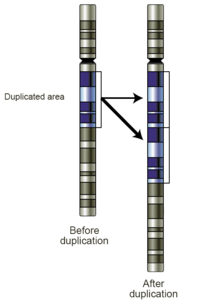
Photo from wikipedia
STUDY QUESTION How well can whole chromosome copy number analysis from a single trophectoderm (TE) biopsy predict true mosaicism configurations in human blastocysts? SUMMARY ANSWER When a single TE biopsy… Click to show full abstract
STUDY QUESTION How well can whole chromosome copy number analysis from a single trophectoderm (TE) biopsy predict true mosaicism configurations in human blastocysts? SUMMARY ANSWER When a single TE biopsy is tested, wide mosaicism thresholds (i.e. 20-80% of aneuploid cells) increase false positive calls compared to more stringent ones (i.e. 30-70% of aneuploid cells) without improving true detection rate, while binary classification (aneuploid/euploid) provides the highest diagnostic accuracy. WHAT IS KNOWN ALREADY Next-generation sequencing-based technologies for preimplantation genetic testing for aneuploidies (PGT-A) allow the identification of intermediate chromosome copy number alterations potentially associated with chromosomal mosaicism in TE biopsies. Most validation studies are based on models mimicking mosaicism, e.g. mixtures of cell lines, and cannot be applied to the clinical interpretation of TE biopsy specimens. STUDY DESIGN, SIZE, DURATION The accuracy of different mosaicism diagnostic thresholds was assessed by comparing chromosome copy numbers in multiple samples from each blastocyst. Enrolled embryos were donated for research between June 2019 and September 2020. The Institutional Review Board at the Near East University approved the study (project: YDU/2019/70-849). Embryos showing euploid/aneuploid mosaicism (n = 53), uniform chromosomal alterations (single or multiple) (n = 25), or uniform euploidy (n = 39) in their clinical TE biopsy were disaggregated into five portions: the inner cell mass (ICM) and four TE segments. Collectively, 585 samples from 117 embryos were analysed. PARTICIPANTS/MATERIALS, SETTING, METHODS Donated blastocysts were warmed, allowed to re-expand, and disaggregated in TE portions and ICM. PGT-A analysis was performed using Ion ReproSeq PGS kit and Ion S5 sequencer (ThermoFisher). Sequencing data were blindly analysed with Ion Reporter software to estimate raw chromosome copy numbers. Intra-blastocyst comparison of copy number data was performed employing different thresholds commonly used for mosaicism detection. From copy number data, different case scenarios were created using more stringent (30-70%) or less stringent criteria (20-80%). Categorical variables were compared using the two-sample z test for proportions. MAIN RESULTS AND THE ROLE OF CHANCE When all the five biopsies from the same embryo were analysed with 30-70% thresholds, only 8.4% (n = 14/166) of patterns abnormal in the original analysis revealed a true mosaic configuration, displaying evidence of reciprocal events (3.6%, n = 6/166) or confirmation in additional biopsies (4.8%, n = 8/166), while most mosaic results (87.3% of total predicted mosaic patterns) remained confined to a single TE specimen. Conversely, uniform whole chromosome aneuploidies (28.3% of total patterns, n = 47/166) were confirmed in all subsequent biopsies in 97.9% of cases (n = 46/47). When 20-80% thresholds were employed (instead of 30-70%), the overall mosaicism rate per biopsy increased from 20.2% (n = 114/565) to 40.2% (n = 227/565). However, the use of a wider threshold range did not contribute to the detection of additional true mosaic patterns, while significantly increasing false positive mosaic patterns from 57.8% to 79.5% (n = 96/166; 95% CI = 49.9-65.4 vs n = 271/341; 95% CI = 74.8-83.6, respectively) (P < 0.00001). Moreover, the shift of the aneuploid cut-off from 70% to 80% of aneuploid cells resulted in mosaicism overcalling in the high range (50-80% of aneuploid cells), impacting the accuracy of uniform aneuploid classification. Parametric analysis of thresholds, based on multifocal analysis, revealed that a binary classification scheme with a single cut-off at a 50% level provided the highest sensitivity and specificity rates. Further analysis on technical noise distribution at the chromosome level revealed a greater impact on smaller chromosomes. LIMITATIONS, REASONS FOR CAUTION While enrolment of a population enriched in embryos showing intermediate chromosome copy numbers enhanced the evaluation of the mosaicism category compared with random sampling such study population selection is likely to lead to an overall underestimation of PGT-A accuracy compared to a general assessment of unselected clinical samples. This approach involved the analysis of aneuploidy chromosome copy number thresholds at the embryo level; future studies will need to evaluate these criteria in relation to clinical predictive values following embryo transfers for different PGT-A assays. Moreover, the study lacked genotyping-based confirmation analysis. Finally, aneuploid embryos with known meiotic partial deletion/duplication were not included. WIDER IMPLICATIONS OF THE FINDINGS Current technologies can detect low-intermediate chromosome copy numbers in preimplantation embryos but their identification is poorly correlated with consistent propagation of the anomaly throughout the embryo or with negative clinical consequences when transferred. Therefore, when a single TE biopsy is analysed, diagnosis of chromosomal mosaicism should be evaluated carefully. Indeed, the use of wider mosaicism thresholds (i.e. 20-80%) should be avoided as it reduces the overall PGT-A diagnostic accuracy by increasing the risk of false positive mosaic classification and false negative aneuploid classification. From a clinical perspective, this approach has negative consequences for patients as it leads to the potential deselection of normal embryos for transfer. Moreover, a proportion of uniform aneuploid embryos may be inaccurately categorized as high-level mosaic, with a consequent negative outcome (i.e. miscarriage) when inadvertently selected for transfer. Clinical outcomes following PGT-A are maximized when a 50% threshold is employed as it offers the most accurate diagnostic approach. STUDY FUNDING/COMPETING INTEREST(S) The study was supported by Igenomix. The authors not employed by Igenomix have no conflicts of interest to declare. TRIAL REGISTRATION NUMBER N/A.
Journal Title: Human reproduction
Year Published: 2023
Link to full text (if available)
Share on Social Media: Sign Up to like & get
recommendations!